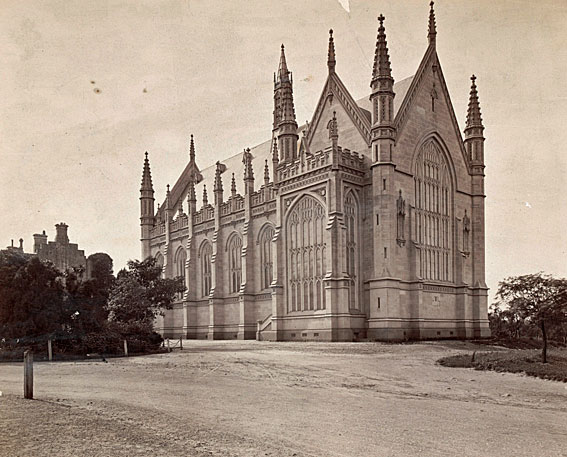
The first Wilson Hall
[image from the State Library of Victoria]

The first Wilson Hall
[image from the State Library of Victoria]
Historical and Technical Documentation by John Maidment
© OHTA, 2012 (last updated August 2012)
Construction of the first Wilson Hall, the gift of Sir Samuel Wilson, who offered the University £30,000 in 1874 for this purpose.1Building began in 1878 and the hall was opened in 1882.2 It was designed in the Perpendicular Gothic style by Joseph Reed and constructed in stone and was built on a very generous scale, larger than Edmund Blacket's earlier and stylistically similar Great Hall at the University of Sydney. Drawings exist of a large organ in the rear gallery of Wilson Hall, but the economic climate was such that this could not be commissioned. The organ recess and gallery had not been built and presumably this would have added substantially to the overall cost. There is no record of Fincham & Hobday, Melbourne's pre-eminent organbuilding firm, being approached for a quotation.
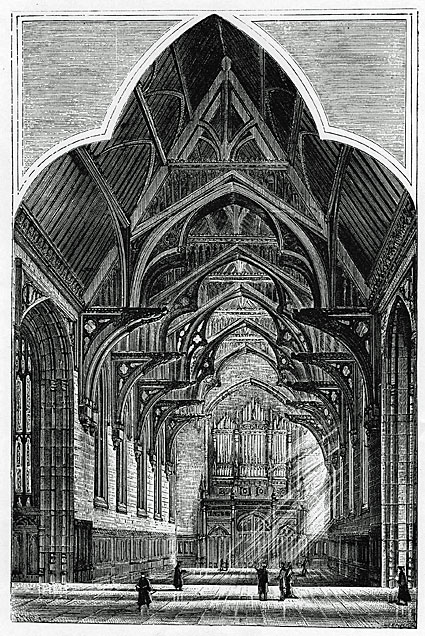
The first Wilson Hall: interior and organ
[Illustrated Australian News, 2 August 1879]
In the 1930s, Hill, Norman & Beard quoted to build a substantial organ for Wilson Hall, envisaged as a donation from philanthropist Norman Brookes. Two schemes survive in his papers at the University of Melbourne Archives. Construction of the organ did not proceed.
In 1952 this building was badly damaged in a major fire. While it may have been feasible to rebuilt it, such was the appreciation of Victorian architecture at the time, and the high cost, it was decided to demolish the remains; some of the stonework was recycled at 'Montsalvat', Eltham.
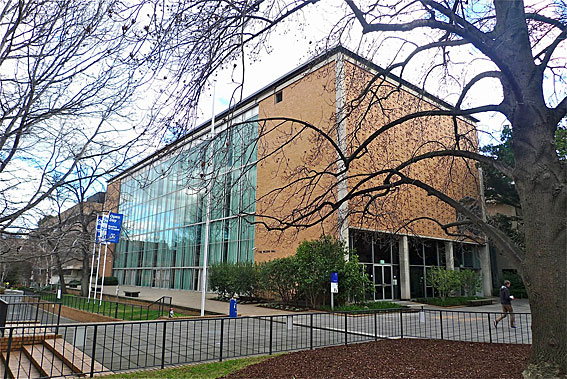
The present Wilson Hall
[photograph by Trevor Bunning (8 August 2012)]
The present Wilson Hall was opened in 1956, sited on the foundations of the 1882 building. The architects were Bates Smart & McCutcheon.3 The building is a rectangular structure, with windows along the eastern face. It includes fine examples of craftsmanship such as the mural Search for Truth designed by Douglas Annand and executed by Tom Bass.
The organ came from the Australian Church in Russell Street, Melbourne, which had recently closed. It had been built for the previous church in Flinders Street by Fincham & Hobday and had been opened in 1890.
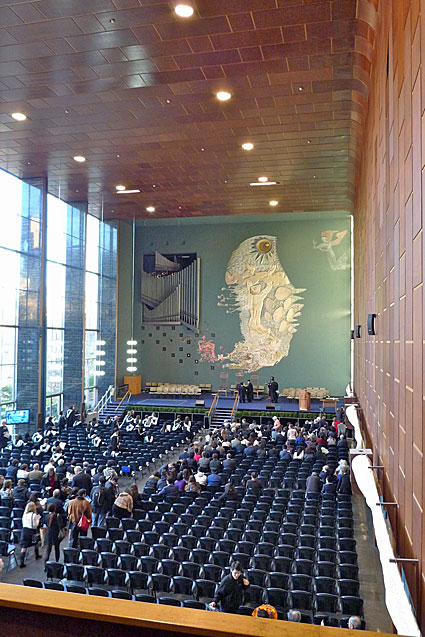
Wilson Hall interior and organ
[photograph by Trevor Bunning (8 August 2012)]
The asymmetrical pipe front, with dummy horizontal trumpets, was designed by the architects and made by Hill, Norman & Beard, who had expectations of securing the main organ contract before the present instrument was gifted to the University from the Australian Church. Its design was to inspire many other locally-built organs, such as the Fincham instrument at St Raphael's Catholic Church, West Preston (1963).
The organ was commissioned in association with a University committee that included in its membership Dr A.E. Floyd, Sir Bernard Heinze and Dr Percy Jones. Given the animosity that existed between the Hill, Norman & Beard managing director W.A.F. Brodie and Floyd, it is not surprising that the Fincham firm was given their full support. George Fincham & Sons had, at the time, Steve Laurie as a member of its staff and he made an important contribution to this project in such things as the tonal design, incorporating Pedal Cornets, in the style of John Compton (with whom Laurie had worked), the Choir mutation registers, and the overall voicing and electrical design. Floyd may have expressed a preference for provision of the Tibias given that he selected such a rank to be added to the organ at St Paul's Cathedral, Melbourne in 1929.
Very sadly, the organ was crammed into a totally inadequate chamber that was lined with copper (an excellent conductor of heat) and tonal egress from the area was sub-standard with pipework speaking into solid walls. The Double Open Diapason 32ft from the Australian Church had to be eliminated from the scheme, and the windchests and pipework were disposed on three levels, the swell boxes sited sideways, owing to the small amount of space provided.
The organ retains the majority of the 1890 Fincham & Hobday pipework. This includes a number of tapered ranks (Great Gemshorn, Choir Gemshorn, Choir Flageolet – originally a Harmonic Gemshorn 2, and the Solo Spitzflote); and the range of imitative reeds – the Cor Anglais has oboe-style resonators, and the Bassoon 16 has been transferred from the Solo to the Choir. The five-rank Mixtures, in the style of Hill & Son, have been retained, these also appearing at the Exhibition Building (1880) and St Kilda Town Hall (1892).
The organ speaks into an interior with a very dry acoustic, well suited to speech, but inimical to musical performance and is subject to enormous temperature variation making accurate tuning very difficult.
| GREAT ORGAN Double Open Diapason Open Diapason no 1 Open Diapason no 2 Open Diapason no 3 Claribel Gemshorn Octave Principal Wald Flute Twelfth Super Octave Fifteenth Mixture Tromba Clarion Swell to Great Choir to Great Solo to Great |
16 8 8 8 8 8 4 4 4 2-2/3 2 2 5 ranks 8 4 |
A B B B |
|
| SWELL ORGAN Bourdon Open Diapason Lieblich Gedeckt Gamba Voix Celeste Principal Suabe Flute Fifteenth Mixture Contra Fagotto Horn Oboe Clarion Tremulant Sub Octave Unison Off Super Octave |
16 8 8 8 8 4 4 2 5 ranks 16 8 8 4 |
TC |
|
| CHOIR ORGAN Violin Diapason Lieblich Gedeckt Dulciana Gemshorn Lieblich Flute Nazard Flageolet Tierce Larigot Sifflote Bassoon Tremulant Sub Octave Unison Off Super Octave Swell to Choir Solo to Choir Pedal to Choir |
8 8 8 4 4 2-2/3 2 1-3/5 1-1/3 1 16 |
(unenclosed) C D C D TC |
|
| SOLO ORGAN Tibia Spitzflote Unda Maris Viol d'Orchestre Voix Celeste Tibia Flute Octaviante Nazard Piccolo Clarinet Cor Anglais Orchestral Oboe Vox Humana Tremulant Tuba Tuba Clarion Sub Octave Unison Off Octave |
8 8 8 8 8 4 4 2-2/3 2 8 8 8 8 8 4 |
(enclosed except Tubas) TC TC E 9 inch wind E 9 inch wind |
|
| BOMBARDE ORGAN Double Open Diapason Open Diapason Octave Tuba Tuba Clarion |
16 8 4 8 4 |
(playable on Choir by reversible piston) B B B E E |
|
| PEDAL ORGAN Acoustic Contrabass Open Diapason Wood Open Diapason Metal Violone Bourdon Octave Bass Flute Viola Octave Quint Fifteenth Bass Cornet Cornet Trombone Trumpet Clarion Great to Pedal Swell to Pedal Choir to Pedal Solo to Pedal |
32 16 16 16 16 8 8 8 5-1/3 4 32 16 16 8 4 |
derived A F G B G F G B 7 ranks derived, with some independent ranks 7 ranks derived, with some independent ranks H H H |
Great pistons to toe pistons on/off
Swell pistons to toe pistons on/off
Compass: 61/30
Detached drawstop console with stopkeys for couplers
The thumb pistons consist of key touches above the respective manuals4
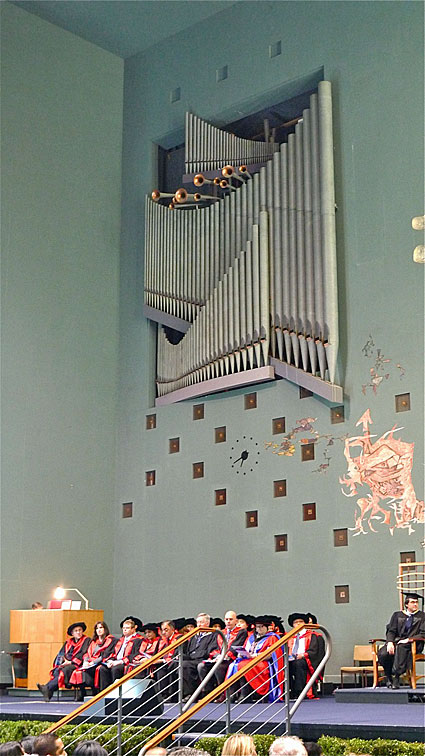
Wilson Hall organ detail
[photograph by Trevor Bunning (8 August 2012)]
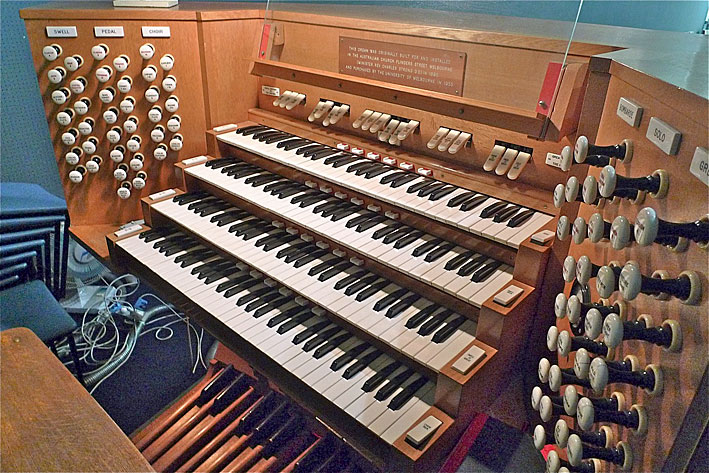
Wilson Hall organ console
[photograph by Trevor Bunning (8 August 2012)]
1 Blake, L. J., 'Wilson, Sir Samuel (1832–1895)', Australian Dictionary of Biography, National Centre of Biography, Australian National University, http://adb.anu.edu.au/biography/wilson-sir-samuel-1052/text8141, accessed 8 August 2012
2 Philip Goad & George Tibbits, Architecture on Campus; a Guide to the University of Melbourne and its Colleges. Carlton: Melbourne University Press, 2003, p.7
3 Ibid, pp.58-59
4 Specification noted John Maidment 1964 with later additions